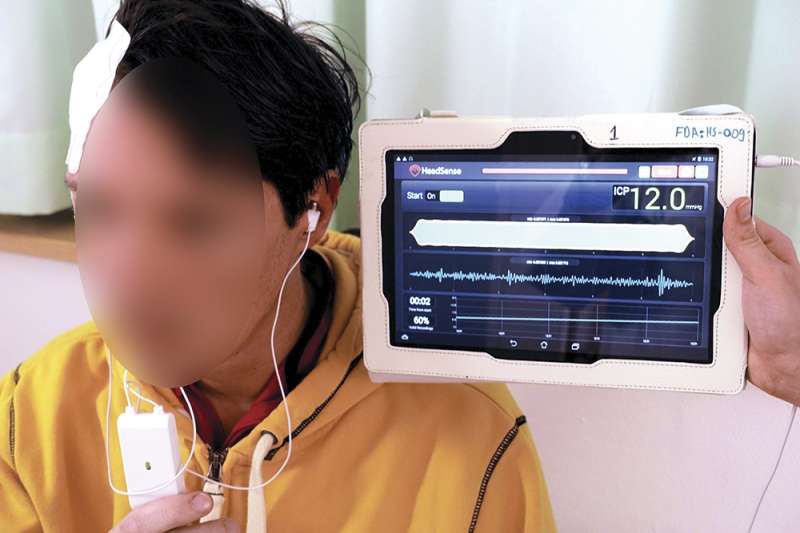New noninvasive method of intracranial pressure monitoring

Researchers from Klinikum Stuttgart and the University of Erlangen, Germany, report preliminary findings that show a noninvasive method of monitoring intracranial pressure (ICP) that could rival the gold standards of invasive intraventricular and intraparenchymal monitoring. To date no noninvasive method of ICP monitoring has proved adequate to replace invasive ones. The new noninvasive monitoring device uses advanced signal analysis algorithms to evaluate properties of acoustic signals that pass through the brain in order to determine ICP values. It is described in the article "Evaluation of a novel noninvasive ICP monitoring device in patients undergoing invasive ICP monitoring: preliminary results," by Oliver Ganslandt, M.D., and colleagues (published today in the Journal of Neurosurgery).
Normally human intracranial pressure (ICP) is 20 mm Hg or lower, but in the presence of brain disease or traumatic head injury, brain tissues may swell or cerebrospinal fluid—the liquid that surrounds and protects the brain—may increase in volume, causing ICP to increase. Increased ICP can cause serious symptoms and sometimes even death. Continuous monitoring of ICP in critical-care patients provides clinicians with the knowledge of whether and when action must be taken to decrease ICP.
To perform invasive ICP monitoring a hole must first be drilled in the patient's skull. A catheter is then inserted into brain tissue (parenchyma) or into a ventricle (a space within the brain that contains cerebrospinal fluid). Sensors in the catheter continuously measure ICP. Intraventricular monitoring is especially useful. An intraventricular catheter can be used both to monitor ICP and to reduce this pressure when it is too high by intermittently extracting excess cerebrospinal fluid.
Intraparenchymal and intraventricular monitoring are gold standards of ICP measurement. However, the procedures required to measure ICP with these methods are invasive. They require opening the skull and carry risks such as bleeding, infection, and damage to brain tissue.
The researchers propose use of an alternative noninvasive ICP monitoring system. They describe the HS-1000 device (HeadSense Medical, Ltd), which emits 6-second-long bursts of sound (66 dB) near one ear. The acoustic signals pass throughout the cranium and, along with physiological brain sounds, are detected by receiving sensors located in the opposite ear. Advanced signal analysis algorithms are used to evaluate properties of the acoustic signals to determine ICP values. Data corresponding to the 6-second epoch are recorded and displayed on the device monitor. The HS-1000 monitoring system can be used continuously, with repeated 6-second epochs, to maintain a constant evaluation of ICP.
The researchers tested the new noninvasive ICP monitoring tool in 14 patients receiving treatment for traumatic brain injury and/or subarachnoid hemorrhage in an intensive care unit. Invasive intraventricular or intraparenchymal monitoring of the patients' conditions was already in place. The researchers then compared ICP values obtained using the noninvasive HS-1000 device with ICP values obtained using an invasive (intraventricular or intraparenchymal) monitoring system.
A comparison of 2543 data points of continuous ICP monitoring showed a strong association between ICP values obtained using noninvasive and invasive methods. Differences in mean ICP values were +/- 3 mm Hg in 63% of data-paired readings and +/- 5 mm Hg in 85% of data-paired readings. The authors point out that similar differences have been found in studies comparing the two invasive methods (intraventricular and intraparenchymal).
The sensitivity and specificity of noninvasive ICP monitoring were determined to be 0.7541 and 0.8887, respectively. Overall, the findings show a good correlation between ICP values obtained using noninvasive and invasive methods of monitoring.
Although this study is preliminary and further investigation is warranted, the authors show that the HS-1000 ICP system provides useful information on normal and elevated ICP values. The authors suggest that use of the device could protect patients from infection and hemorrhage—potential risks of invasive ICP monitoring—and also could aid clinicians in deciding when invasive ICP monitoring may be appropriate.
When asked about the study, Dr. Ganslandt said, "The first results look promising, but further refinements in the algorithm will be necessary to allow a reliable clinical application."
More information: Ganslandt O, Mourtzoukos S, Stadlbauer A, Sommer B, Rammensee R. Evaluation of a novel noninvasive ICP monitoring device in patients undergoing invasive ICP monitoring: preliminary results. Journal of Neurosurgery, published online, ahead of print, August 8, 2017; DOI: 10.3171/2016.11.JNS152268



















